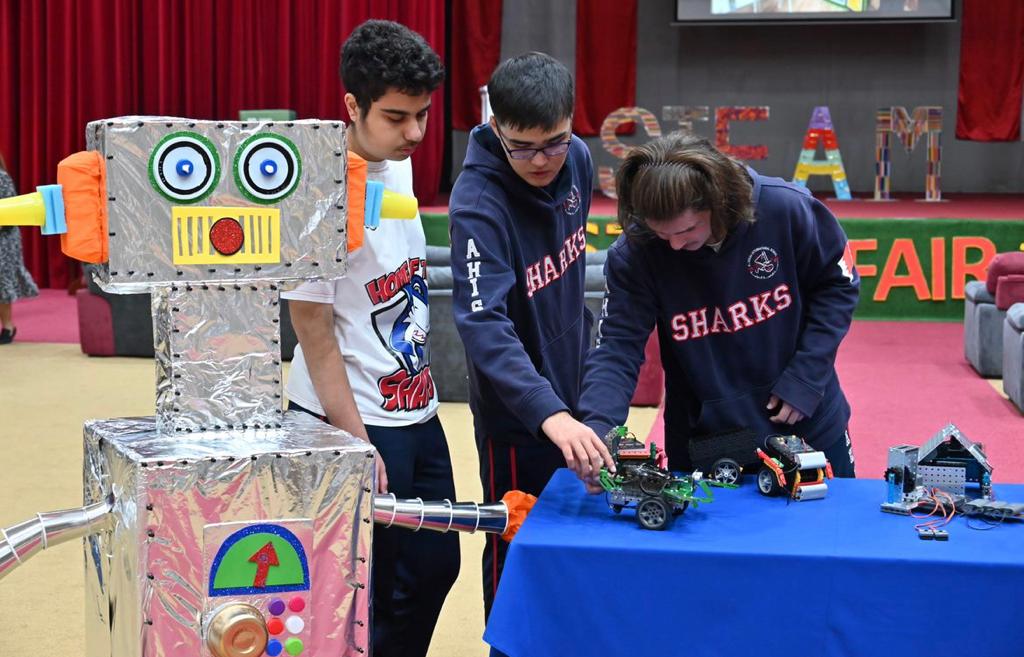In the digital age, the integration of artificial intelligence (AI) and STEAM (Science, Technology, Engineering, Arts, and Mathematics) education has become crucial in preparing students for a rapidly evolving future. The combination of AI and STEAM offers a powerful framework that fosters critical thinking, creativity, problem-solving, and technical skills. In this article, we will explore the benefits and challenges associated with incorporating AI and STEAM in schools, and how this integration can revolutionize the educational landscape. For example in Al Hekma International School/Bahrain (AHIS), the school implements STEAM program to foster ingenuity, build resilience, encourage experimentation, nurture teamwork and knowledge application, and motivate creativity and problem solving among its students. STEAM approaches in AHIS help students to learn skills relevant to the 21st century, including innovation and cultural sensitivity. This also enables teachers to use differentiated instruction to meet the needs of diverse students. AHIS uses different STEAM approaches such as:
-Scheduling a dedicated weekly period for STEAM.
-Aligning the curriculum
-Designing a STEAM reward program for students. -Allocating space for students to work on their STEAM ideas and projects “Innovation Hub”.
-Supporting students to participate in local and international STEAM competitions.
-Organizing an annual STEAM fair -Integrating STEAM in-class work , homework and assessments.
Benefits of Integrating AI and STEAM in Schools:
1. Enhanced Learning Experiences: AI-powered tools and platforms can provide personalized learning experiences tailored to individual students' needs, enabling them to learn at their own pace and style. AI can adapt content, offer real-time feedback, and provide additional resources, fostering a more engaging and effective learning environment.
2. Practical Application of Concepts: AI allows students to apply theoretical knowledge to real-world scenarios. For example, they can develop AI models to solve complex problems, design algorithms, or use robotics to automate tasks. This hands-on approach encourages creativity, critical thinking, and problem-solving skills.
3. Career Readiness: By integrating AI and STEAM, students gain exposure to emerging technologies and develop relevant skills sought in the job market. These skills include data analysis, programming, computational thinking, and problem-solving, preparing students for careers in fields such as data science, robotics, cybersecurity, and AI research.
4. Interdisciplinary Collaboration: AI and STEAM integration promotes collaboration among students from different disciplines. For instance, students can work together on robotics projects, combining their expertise in programming, engineering, and design. This collaboration nurtures teamwork, communication, and respect for diverse perspectives.
There are several AI-powered tools that can be used in STEAM education to enhance learning experiences and foster creativity and problem-solving skills. Here are some examples:
1. Robotics Kits: Robotics kits, such as LEGO Mindstorms and VEX Robotics, integrate AI technologies to enable students to build and program robots. These kits often include sensors, motors, and programmable controllers that allow students to design autonomous robots and explore concepts like computer vision, motion planning, and machine learning.
2. Virtual Reality (VR) and Augmented Reality (AR): VR and AR technologies offer immersive experiences that can enhance STEAM education. Students can use VR headsets to explore virtual environments, such as the solar system or historical landmarks, providing a deeper understanding of scientific concepts or historical events. AR applications allow students to overlay digital information onto the real world, enabling interactive learning experiences.
3. Natural Language Processing (NLP) Tools: NLP tools, like chatbots or language processing libraries, can be used to develop language-based AI applications. Students can create chatbots that simulate conversations or build language models that generate text, fostering creativity and language understanding.
4. Data Visualization Tools: AI-powered data visualization tools allow students to explore and analyze data sets visually. These tools enable students to identify patterns, trends, and relationships within data, enhancing their data analysis and interpretation skills.
5. Coding Platforms: Platforms like Scratch, Python, or Arduino offer AI-focused coding environments that allow students to program AI algorithms and explore machine learning concepts. Students can create interactive projects, build AI models, and experiment with AI algorithms, developing computational thinking and programming skills.
6. Adaptive Learning Systems: Adaptive learning systems, such as Khan Academy, use AI algorithms to personalize educational content and adapt to students' individual needs. These systems analyze student performance, identify areas of improvement, and provide tailored learning paths, promoting self-paced learning and individualized instruction.
These AI-powered tools provide students with hands-on experiences, promote creativity, and foster critical thinking and problem-solving skills across various STEAM disciplines. By incorporating these tools into the curriculum, educators can create engaging and interactive learning environments that prepare students for the future.
In conclusion the integration of AI and STEAM in schools has the potential to revolutionize education by empowering students with essential skills for the future. By embracing AI technologies, students can engage in experiential learning, develop critical thinking and problem-solving abilities, and prepare for the demands of the digital era. However, to maximize the benefits of AI and STEAM, it is crucial to address challenges related to access, teacher training, and ethical considerations. By doing so, we can unlock the full potential of AI and STEAM education, equipping students with the tools they need to thrive in an AI-driven world.


